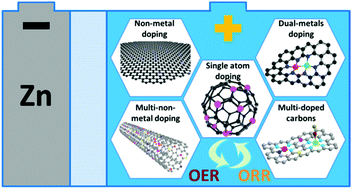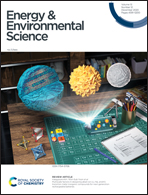Heteroatom-doped carbon catalysts for zinc–air batteries: progress, mechanism, and opportunities
Abstract
Zinc–air batteries are regarded as promising candidates for next-generation clean and sustainable energy storage devices, due to their low-cost, safety, eco-friendliness, and high specific energy density. In zinc–air batteries, the air catalysts accelerate the sluggish oxygen electrocatalysis and largely govern the overall battery performance. Among the air catalysts, carbon-based materials have attract great attention, owing to their high conductivity, chemical robustness, porous structure, and tunable composition. Herein, this review presents the recent progress in bifunctional heteroatom-doped carbon catalysts for zinc–air batteries, especially for rechargeable and flexible batteries. The review will start with a brief introduction of the development, advantages, and types of zinc–air batteries. Then, the application of bifunctional heteroatom-doped carbon catalysts for aqueous and solid-state/flexible zinc–air batteries will be summarized. In the review, an emphasis is given for the investigations on reaction mechanisms, along with corresponding discussions on the role of non-metal and metal dopants. Theoretical predictions will also be discussed to guide the design and fabrication of future bifunctional carbon-based catalysts. Finally, a general perspective on the challenges and opportunities for the future innovation of heteroatom-doped carbon-based catalysts for zinc–air batteries is presented.



 Please wait while we load your content...
Please wait while we load your content...